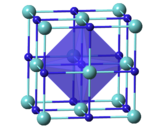Zirconium nitride

| |
| Names | |
|---|---|
| IUPAC name
Zirconium nitride
| |
| Other names
Zirconium(III) nitride, Nitridozirconium
| |
| Identifiers | |
3D model (JSmol)
|
|
| ChemSpider | |
| ECHA InfoCard | 100.042.864 |
| EC Number |
|
PubChem CID
|
|
CompTox Dashboard (EPA)
|
|
| |
| |
| Properties | |
| ZrN[1] | |
| Appearance | Yellow-brown crystals |
| Odor | Odorless |
| Density | 7.09 g/cm3 (24 °C)[1] |
| Melting point | 2,952 °C (5,346 °F; 3,225 K) at 760 mmHg[1] |
| Insoluble | |
| Solubility | Soluble in concentrated HF, acids[1] |
| Structure | |
| Cubic, cF8[2] | |
| Fm3m, No. 225[2] | |
a = 4.5675 Å[2] α = 90°, β = 90°, γ = 90°
| |
| Octahedral[2] | |
| Thermochemistry | |
Heat capacity (C)
|
40.442 J/mol·K[3] |
Std molar
entropy (S |
38.83 J/mol·K[3] |
Std enthalpy of
formation (ΔfH⦵298) |
−365.26 kJ/mol[3] |
| Related compounds | |
Related refractory ceramic materials
|
Tantalum carbide Niobium carbide Zirconium carbide |
Except where otherwise noted, data are given for materials in their standard state (at 25 °C [77 °F], 100 kPa). | |
| Infobox references | |
Zirconium nitride (ZrN) is an inorganic compound used in a variety of ways due to its properties.
Properties[]
ZrN grown by physical vapor deposition (PVD) is a light gold color similar to elemental gold. ZrN has a room-temperature electrical resistivity of 12.0 µΩ·cm, a temperature coefficient of resistivity of 5.6·10−8 Ω·cm/K, a superconducting transition temperature of 10.4 K, and a relaxed lattice parameter of 0.4575 nm. The hardness of single-crystal ZrN is 22.7±1.7 GPa and elastic modulus is 450 GPa.[4]
Uses[]

Zirconium nitride is a hard ceramic material similar to titanium nitride and is a cement-like refractory material. Thus it is used in refractories, cermets and laboratory crucibles. When applied using the physical vapor deposition coating process it is commonly used for coating medical devices,[5] industrial parts (notably drill bits), automotive and aerospace components and other parts subject to high wear and corrosive environments. When alloyed with Al, the electronic structure develops from local octahedral bond symmetry of cubic ZrN that distorts for increasing Al content into more complex bonding and higher hardness.[6]
Zirconium nitride was suggested as a hydrogen peroxide fuel tank liner for rockets and aircraft.[7]
References[]
- ^ a b c d Lide, David R., ed. (2009). CRC Handbook of Chemistry and Physics (90th ed.). Boca Raton, Florida: CRC Press. ISBN 978-1-4200-9084-0.
- ^ a b c d Sirajuddeen, M. Md. Sheik.; Banu, I. B. S. (2014). "FP-LAPW investigation of electronic, magnetic, elastic and thermal properties of Fe-doped zirconium nitride". AIP Advances. 4 (5): 057121. Bibcode:2014AIPA....4e7121S. doi:10.1063/1.4879798.
- ^ a b c Zirconium nitride in Linstrom, Peter J.; Mallard, William G. (eds.); NIST Chemistry WebBook, NIST Standard Reference Database Number 69, National Institute of Standards and Technology, Gaithersburg (MD), http://webbook.nist.gov (retrieved 2014-06-30)
- ^ Mei, A. B.; Howe, B. M.; Zhang, C.; Sardela, M.; Eckstein, J. N.; Hultman, L.; Rockett, A.; Petrov, I.; Greene, J. E. (2013). "Physical properties of epitaxial ZrN/MgO(001) layers grown by reactive magnetron sputtering". Journal of Vacuum Science & Technology A: Vacuum, Surfaces, and Films. 31 (6): 061516. Bibcode:2013JVSTA..31f1516M. doi:10.1116/1.4825349.
- ^ "IonFusion Surgical". IonFusion Surgical, Inc. Retrieved 2014-06-30.
- ^ M. Magnuson; W. Olovsson; N. Ghafoor; M. Oden; L. Hultman (2020). "Interface bonding of Zr1-xAlxN nanocomposites investigated by X-ray spectroscopies and first-principles calculations". Phys. Rev. Research 2: 013328. doi:10.1103/PhysRevResearch.2.013328.
- ^ US 7736751, Yousefiani, Ali, "Coating for components requiring hydrogen peroxide compatibility", published 2010-06-15, assigned to Boeing Co.
- Nitrides
- Zirconium compounds
- Superhard materials
- Refractory materials
- Rock salt crystal structure
- Inorganic compound stubs